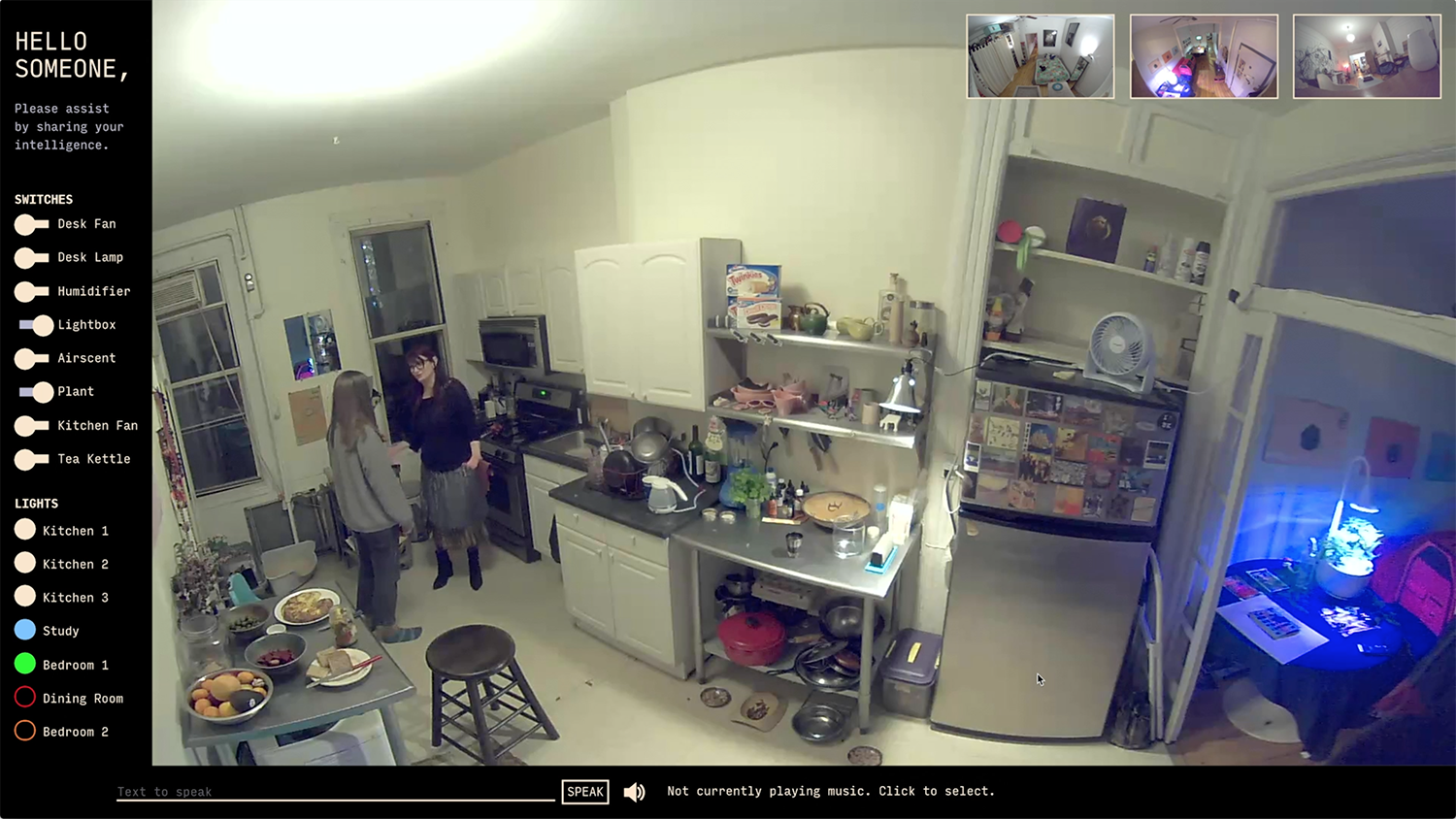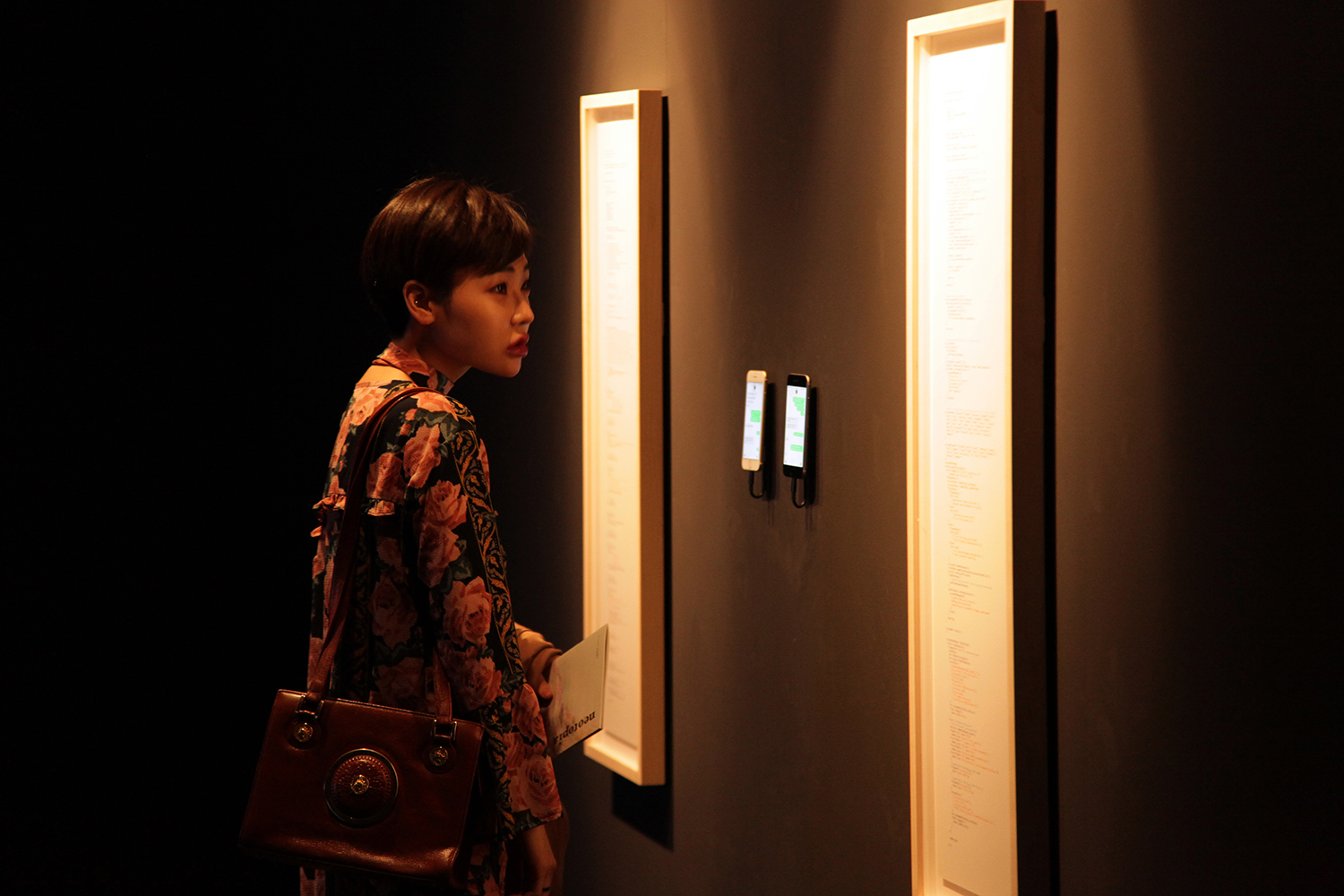Device and I, the connection becomes a new existence.
When you wake up early in the morning to the alarm, the wearable thermometer tells you your basal body temperature. After brewing a cup of coffee at a preset water temperature, also the time to feed the dog is being checked. Then, you wear clothes recommended by AI according to the weather and leave the house.
Now, how many sensors and devices have been applied so far? Let’s think about it. Of course, there is one thing for sure. People are already very familiar with various types of devices. In particular, AI smart home systems such as Amazon’s Alexa, Apple’s Siri, and Google’s Google Assistant are closely linked to people’s daily lives.
‘SOMEONE’ by the artist Lauren McCarthy is a smart home system that extends the human senses. The project has also won the ‘Golden Nica of the 2020 Prix Ars Electronica’. providing information and convenience to users is just like any other smart home systems. For example, it shuts off the power when water in a kettle boils and it turns off the lights when the user falls asleep.
The only thing different is the identity of SOMEONE. A visitor to the gallery, not AI observes the user with a laptop installed in the exhibition, communicates with the user, and remotely controls the indoor smart devices. So, the role of AI is replaced by humans. Can SOMEONE make users feel more comfortable than AI?
Hyper-connected Society of Human-Device-Human
SOMEONE is connected with multiple devices. Of course, it applies the same to users. The interesting part is the relationship between users and SOMEONE. Can users accept SOMEONE as a simple management system under this circumstance? Also, how is SOMEONE going to treat users? Lauren McCarthy asks how the SOMEONE project will lead to the human-to-human relationship that emerges behind device connectivity.
Q. In our hyper-connected society, what does it mean to you to be connected with mechanical devices?
I’m less interested in being connected to devices and much more interested in connecting to people through devices. Unfortunately, a lot of the devices and platforms around us are designed to focus more on the first thing, keeping people connected to them. Putting an interface between people does not by default bring them closer. To get through to others in a meaningful way, we must actively reflect on the technologies we choose to engage with and how we’re using them. There are many examples of people finding community and connection through networks. I’d like to see more of this, more people exploring new ways of doing this.
Human Expansion and Post-human
Then, how will communication equipment that expands human communication be evolved? The artist suggested the possibility of ‘us+’ and ‘pplkpr’ projects. The former one controls users’ activities by analyzing the language data of video calls, and the latter one is an application developed by a virtual startup that helps users optimize human relationships by reading emotional/sentimental responses when interacting with others with a smartwatch. The idea of optimizing human relationships may seem a bit radical, but don’t you think you might want to rely on it at least once if a machine can read emotions tells you how to respond all the time?
Smart devices only need to become more diverse in the future. People are getting more interested in caring, stability, and bonding such as smart homes and humanoid companion robots, etc. The artist also created a service in ‘I.A. Suzie’ project can replace friends, family, and medical staffs, and presents necessary/possible AI to the elderly. What if an AI robot appears that can fully understand and directly take care of a specific user?
Q. If AI robots provide a 1:1 caring function and become partners, can they also be called ‘post-human’?
A. What do you think ‘human’ is? Most people seem to think that there is a clear line between AI and humans. However, this boundary will become more blurred in the future. People rely on assistive technologies ranging from devices as simple as glasses to pacemakers and hearing aids to smartphones. It will be meaningless in the future in distinguishing between natural human intelligence and AI or considering purely ‘human’ values first. In the end, we will have to think about the values we need to keep in the flow of human expansion with technology.
The Future of Technology
People are facing the outcomes selected by algorithms in almost every field every day using intelligent AI technology that learns and judges on their own. We asked about this flow that we encountered.
Q. What are the pros and cons of letting machines make our decisions, or even speaking for us?
As the speed of interaction and communication increases, we may be tempted to rely on tools like autoreply, automation, and algorithmic recommendations. But many algorithmic systems are trained on existing datasets that incorporate bias and inequity. By allowing these systems to make decisions for us, we risk propagating those biases and limiting the set of possible outcomes for any situation.
Of course, these concerns are not limited only to algorithms. It will be more important to prioritize as the technology surpasses human capabilities far beyond in certain areas. The typical example is the ‘Ethics of Artificial Intelligence.’ Experts are studying criteria to prevent AI from making judgments that compromise human dignities, such as self-driving cars, chatbots, deep fakes, embryo experiments, insurance businesses, and facial recognition. In a world that is rapidly merging and changing so the boundary between man-made and nature is blurred, where will the artist’s next project be headed towards?
Q. Have there been any recent technological developments that have caught your eye? If so, why?
I’ve been thinking a lot about reproductive and genetic technologies. When it comes to the range of technology from IVF and egg freezing to CRISPR, there are so many large questions about how we view our humanity and how much control we will attempt to exert over it. What happens when ideas of optimization and algorithmic prediction are applied directly to reproduction? Will confronting these questions lead us to a dystopia or push us to get beyond our narrow ideas of what it is to be a person deserving of a good life?
About the artist
Lauren Lee McCarthy is an artist/computer programmer based in Los Angeles and Brooklyn. She studied computer science as well. and she is currently working as an Associate Professor at UCLA Design Media Arts. exploring social relationships with various keywords such as surveillance, monitoring, automation, and algorithmic living. She works with a variety of interdisciplinary approaches, collaborating with artists and engineers in different fields. She has exhibited her work in Seoul and Gwangju in Korea.
Cover. Lauren Lee McCarthy, SOMEONE (2019). Courtesy of the artist
• Lauren Lee McCarthy, SOMEONE (2019). Screenshots by Lauren Lee McCarthy
• Lauren Lee McCarthy & Kyle McDonald, pplkpr (2015). Courtesy of the artists
• Lauren Lee McCarthy and Kyle McDonald, MWITM(Man / Woman In The Middle) (2018). Courtesy of the artists




